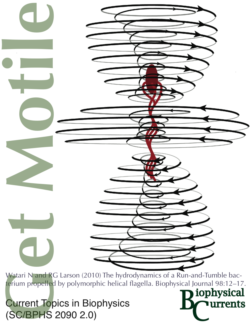 Welcome to the Current Topics in Biophysics (SC/BPHS 2090.03, crosslisted as SC/BIOL 2090.03) course website, containing
course information, handouts, and important news for the course. Please visit often because
information will sometimes be posted on this website before being announced in class.
Here is information about the
Biophysics degree program.
Welcome to the Current Topics in Biophysics (SC/BPHS 2090.03, crosslisted as SC/BIOL 2090.03) course website, containing
course information, handouts, and important news for the course. Please visit often because
information will sometimes be posted on this website before being announced in class.
Here is information about the
Biophysics degree program.
14 August 2014: Here is the annual reminder to students of the University Senate Policy regarding Academic Honesty: Both the University Policy and additional resources for students.
23 jul 2014: Biophysics in the News: Evolving Flight
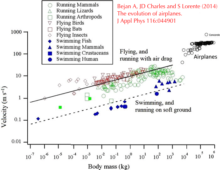
Biological scaling is often used to make sense of biological Size and Shape. A recent article in the Journal of Applied Physics: The Evolution of Airplanes takes biological scaling one step further, including airplanes in a graph of velocity versus mass. Even though the energetics of a combustion-driven airplane are different, airplanes don't deviate that much from the linear fit of a log-log plot. The authors claim "The evolution of technology, river basins, and animal design is one phenomenon, and it belongs in physics.", but life is a bit more complicated than that. Biological respiration/photosynthesis evolved over one thousand million years --locomotion for even longer-- to maximize species survival, not to transport humans around the globe.
09 jul 2014: Biophysics in the News: Three-dimensional Synapses
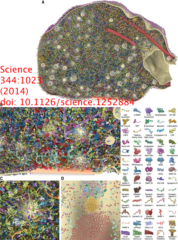
With the development of new science technologies --most especially high resolution imaging-- there is an ongoing revolution in our understanding of intracellular architecture. The arrangement of proteins in three dimensional space reveals a great deal about how cellular processes occur. One example is neurotransmitter release at synapses, which requires a remarkable assemblage of different proteins to occur correctly. Recent progress in three dimensional imaging of the arrangement of various proteins at synapses is highlighted in a press release from the Leibniz-Institut fur Molekulaire Pharmakologie: First 3D Model of a Synapse. The sciency article was published in Science: Composition of isolated synaptic boutons reveals the amounts of vesicle trafficking proteins.
23 jun 2014: Biophysics in the News: Repelling Water
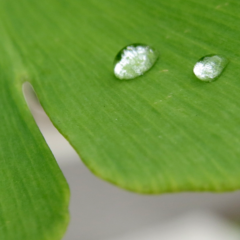
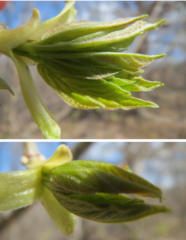
Biological surfaces are a marvel of micro-engineering. Aatish Bhatia explores the ability of leaf surfaces to repel water at his Empirical Zeal blog (Wired magazine): The Amazing Micro-Engineered, Water-Repelling Surface That Lives Outside My Window. There is more to this than just repelling water. Leaf surfaces are self-cleaning, and are actively studied as engineers develop surfaces inspired by leaf biomimetics. The blog has some high-speed movies showing how water droplets bounce when they fall onto the leaf. It's a five thumbs-up movie experience for a biophysicist.
16 jun 2014: Biophysics in the News: Ant Rafts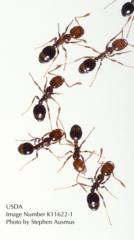
Ants are well known bio-engineers. Besides farming aphids and fungi and creating architecturally complex colonies (see the Wikipedia ant article for details), they are also capable of creating rafts that float on water --and other structures-- by grasping each other in a complex three-dimensional assemblage. Is this important? Yes. It could be the inspiration for self-assembling micro-robots! Nature describes the recent research on ant assemblages (including a video). The 'sciency' article was published in the Journal of Experimental Biology: Fire ants actively control spacing and orientation within self-assemblages.
16 jun 2014: Biophysics in the News: Inter-Bacterial Nano-Wiring
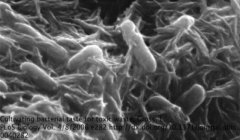
Nanotechnology has been around for at least 35 years (when the first nano-fabrication laboratories were set up), but the technology has improved, leading to fascinating discoveries in basic science. Electrical conduction between bacterial cells is one example. Moh El-Naggar used a nanotech approach to deomstrate that bacteria connect to each other with nanowires to share electricity. PBS provides a 'newsy' description of the discovery and the people doing the research. The 'sciency' article was published in PNAS: Electrical transport along bacterial nanowires from Shewanella oneidensis MR-1.
20 nov 2013: Biophysics in the News: Photosynthetic Machines
There will be a Public Lecture (Tuesday 26 November at 7:30 pm) by the 2012 NSERC Polanyi Prize Winner Gregory Scholes: Photosynthetic Machines: Why Nature is Astounding. He will be introduced by Nobel Laureate John C. Polanyi.
"Photosynthetic solar energy conversion occurs on an immense scale across the earth, influencing our biosphere from climate to oceanic food webs. These are amazing solar cells!Scholes is very well known for his research on the initial exciton transfers after light absoprtion, where quantum effects are now known to occur even at room temperature. It's strong evidence that Biology discovered Quantum Physics more than 3500 million years ago!
Fronds in kelp forests, crustose coralline algae and purple bacteria show interesting properties that are helping reveal the chemical physics involved in the ultrafast energy transfers of light harvesting. This talk introduces the incredible processes that initiate photosynthesis in the first picoseconds after light is absorbed."
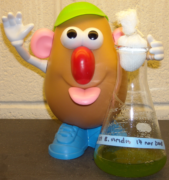 14 nov 2013 Biophysics in the News: The Power of the Spud.
14 nov 2013 Biophysics in the News: The Power of the Spud.
BBC Future highlights something that many of you may already be aware of: The ability to create electricity using a potato (oranges and even onions will also work). The 'spin' was that the current supply can be ramped up to the point where the light (from LED lamps) can be quite bright. They do this by "slicing the potato into four or five pieces, each sandwiched by a copper and zinc plate, to make a series". The Biophysics Club ran a Science Olympics competition (Biophysical Currents) in 2011. Club members provided a variety of fruits and vegetables to the competing high school teams. The teams selected which one they would use based on prior experimentation at their schools: the team achieving the highest current and best written rationale received first place. Many teams opted for oranges over either potatoes or onions! 'Leftovers' went to a local food bank.
22 sep 2013 Biophysics in the News:
Evolution and Selective Pressure: antibiotic resistance in bacteria.
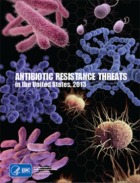
In lecture, I used antibiotic resistance of bacteria as an example of a selective pressure causing evolution of survival traits, emphasizing the role of increased mutation rates and R-plasmids (as a way for bacteria to share the resistance genes). The Center for Disease Control has just published a report on the alarming trend of antibiotic resistant diseases in humans. It's worrisome. For us, ensuring we only use antibiotics as required and following the instructions for a complete course of antibiotic treatment are both important. For researchers, discovery of new classes of antibiotics --either from nature or as designed drugs-- will help but not eliminate the evolution of antibiotic resistance. The newsy article is in Wired Magazine. The sciency report is at the CDC website.
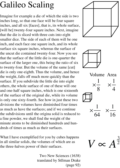 02 jul 2013 Biophysics in the News: Galileo Scaling.
02 jul 2013 Biophysics in the News: Galileo Scaling.
Okay, it's old news (375 Years Old), but Galileo scaling is a big deal. The general concept is that volume and area scale differently with size. In biology, it's extraordinarily important because volume and metabolism go hand in hand, but nutrient uptake scales with area. So, biological design has evolved in ways that maximize uptake (area) compared to mass (or volume). Galileo presents volume/area scaling in great detail in his book entitled Two New Sciences. The evolutionary design aspects are well understood by biologists. The physicists have lots of fun scaling organisms (mostly humans) to show how important Galileo Scaling is. Michael Fowler has good explanations of Galileo Scaling on his website for a course Galileo and Einstein.
23 apr 2013 Biophysics in the News: Animalcules Redux: the fantastic world of micro-swimmers.
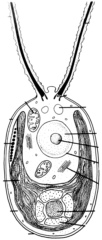
At the 2012 annual meeting of the American Physical Society, Raymond Goldstein gave a talk on micro-swimmers. He started out his presentation by highlighting important biological problems for physicists, and included his own area of research: the evolution of multi-cellularity. Lew's lecture on Biological Pumps rely in part on Goldstein's work. A video of Goldstein's talk is available at the American Physical Society website.
12 dec 2012 Biophysics in the News: X-Ray micro-tomography
Wired Magazine highlights some amazing images using x-rays and tomography to examine the internal structure of organisms. The technique involves re-constructing three dimensional structures from two dimensional slices. With x-rays, the internal structures can be visualized. The work was done by Sarah Faulwetter at the Hellenic Centre for Marine Research and are collected on her youtube channel. These types of techniques are deep biophysics, an on-going revolution in imaging.
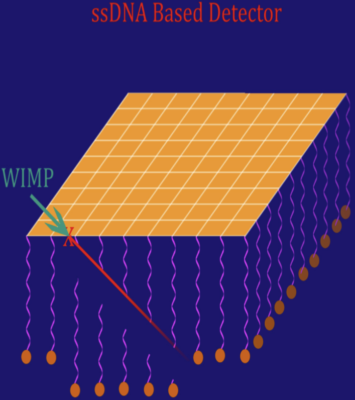 13 dec 2012 Biophysics in the News:
Dark Matter and DNA
13 dec 2012 Biophysics in the News:
Dark Matter and DNA
This one is more for the high energy particle physicists than it is for the biophysicists.... It's an idea for obtaining evidence for dark matter in the universe, using long single stranded DNA molecules. The high energy particles would break the DNA, which could then be sequenced to obtain the lengths. The DNA molecules would be housed in a multi-array system to capture as many events as possible. The idea arose from casual conversation between physicists and molecular biologists. It was highlighted by the Washington Post. The details were outlined in an Arxiv Astrophysics paper New Dark Matter Detectors using DNA for Nanometer Tracking.
12 dec 2012 Biophysics in the News: Gollum's Fishies
Rhett Allain --a writer for Wired magazine-- has a way of taking serious biological problems requiring physical approaches and spinning them to capture the interest of a broader audience. So, he asks "How many fish does Gollum need?". The answer lies in the balence between metabolic heat production and radiative energy loss, something students have seen before in a boiling human assignment [pdf]. Here is Rhett's approach. Missing from his analysis --and exceedingly important-- is advective heat loss caused by breathing.
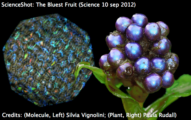 12 sep 2012 Biophysics in the News:
The Bluest Fruit
12 sep 2012 Biophysics in the News:
The Bluest Fruit
The biophysics of color is an astonishing area of research. Usually, we think about color as being a property of molecules and how they absorb light (something Dr. Jerzak will explore in his lectures). But there's more. Some colors --especially those we would describe as iridescent-- are created by the physical interactions between photons and the substrate in a multi-layer-based structural color. The most recent of these is described in the Proceedings of the National Academy of Science. It is the fruit of Pollia condensata. The non-edible blue-colored berry has evolved to attract pollinators (birds) solely on the basis of the extraordinarily intense color. There is an obvious practical application to this research: Developing colors that never fade.
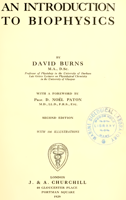 27 aug 2012 Biophysics in the News:
Historical Biophysics
27 aug 2012 Biophysics in the News:
Historical Biophysics
We usually think of biophysics as a recent science, forged in the heart of the molecular biological revolution. This is true, but there is an older history... I came across a book by David Burns entitled An Introduction to Biophysics recently, published more than 80 years ago. The book itself is available at the internet archive. The table of contents is different from a modern textbook, but there are things you would recognize: energetics, cellular mechanics, cell communities, transport, etcetera. It is fascinating example of how science and scientific knowledge evolve over time, so that biophysics means much more now than it did in 1929 when Burns was a Professor of Physiology at the University of Durham.
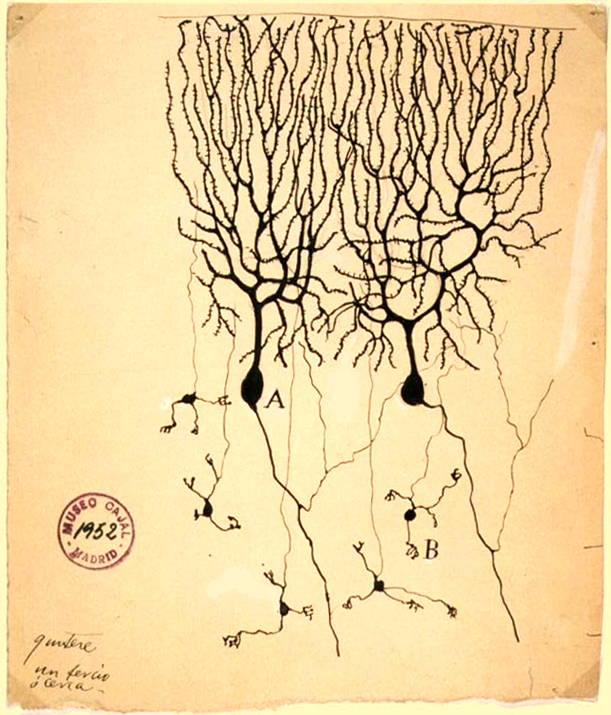 23 aug 2012 Biophysics in the News:
High Resolution Neurons
23 aug 2012 Biophysics in the News:
High Resolution Neurons
Wired Magazine seems to be the place for biophysical advances. In this news article, they highlight some recent advances in our understanding of transport in neurons. Here's the teaching moment: Neurons have a cell body from which long narrow extensions --axons and dendrites-- extend out to contact either the substrate or other cells, including neurons. Material has to be transported from the cell body (where the nucleus is) to the ends of the extensions, and the cell has to distinguish between axons and dendrites. By using green fluorescent tagged proteins and a pulse/chase technique, scientists were able to explore how separate trafficking of different proteins occurs. The scientific report was published in Cell Reports. Besides being an important advance, the movies are totally cool.
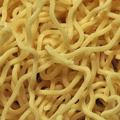 20 aug 2012 Biophysics in the News:
Ramen Noodles and DNA
20 aug 2012 Biophysics in the News:
Ramen Noodles and DNA
Wired Magazine highlights the work of Erez Aiden on DNA entanglement in chromosomes, using ramen noodles as an example. The science underlying the highlight (fractal globules) has to do with the structure of DNA in chromosomes and its availability for expression of genes. The more sciencey aspects were published in Science in 2009. The research required heavy duty DNA sequencing and massive parallel computer processing, a natural environment for budding biophysicists.
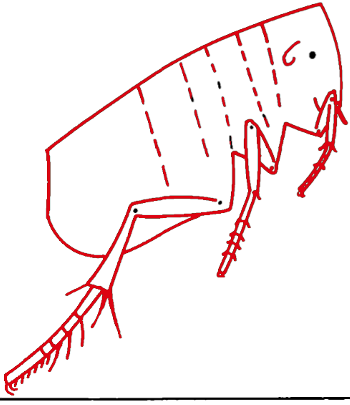 4 aug 2012 Biophysics in the News:
Olympic Long Jumps
4 aug 2012 Biophysics in the News:
Olympic Long Jumps
In a recent article in Wired Magazine, Rhett Allain looks at some of the physical constraints on how far a human can jump in the Olympic Long Jump Competition. He uses the Olympic record-breaking long jump of 8.90 meters by Bob Beamon in Mexico City in 1968 and considers the effects of gravity and air density. Mexico City is at an elevation of about 2400 meters, so gravity and air density will both be lower. The upshot is no significant effect, but the calculations should be familiar to students taking BPHS2090 (they could even be used in an assignment!). The article is a fun read.
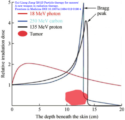 31 may 2012 Biophysics in the News:
Particle therapy for cancers: a new weapon in radiation therapy
31 may 2012 Biophysics in the News:
Particle therapy for cancers: a new weapon in radiation therapy
In a recent article in Frontiers in Medicine, Guo-Liang Jiang reviews the prospects for particle beam treament of tumours in the human body [link]. It may be the start of a revolution a long-time coming. Professor Scott Menary has given guest lectures on Biomedical Applications of Accelerators [.ppt] that introduces the physics and the biomedical prospects. The major advantage of proton or carbon beams is the ability to focus the beam deep in the body, to assure maximal targetting of the tumour and minimal damage to surrounding tissue. This area of research and its applications are one possibility for a future career, in Medical Physics.
 6 may 2012 Biophysics in the News:
Life at Low Reynolds Number
6 may 2012 Biophysics in the News:
Life at Low Reynolds Number
The modern technology of MicroFluidics [Wikipedia] has its roots in MicroPhysics, or Life at low Reynolds Number, which also dominates the movement of swimming cells. You can read the classic paper by the Nobel Laureate Edward Purcell at the American Journal of Physics about Life at Low Reynolds Number. A classic movie entitled Low Reynolds Number Flows starring the physicist GI Taylor has been uploaded onto YouTube. It provides a dramatic insight into the nature of low Reynolds number fluidics.
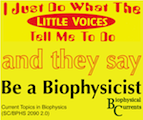 24 apr 2012 Biophysics in the News:
What is a Biophysicist?
24 apr 2012 Biophysics in the News:
What is a Biophysicist?
There is such a diversity of things that can be categorized as biophysics! The Biophysical Society tries to give a flavour of that diversity by trying to answer the question What is Biophysics?.The range of biophysics is daunting: from molecular machines to systems engineering, from protein structures to the architecture of metabolomes, from diffusive to advective fluxes, from sonic to photonic imaging, from biomechanics to quantum engineering in photosynthesis. The possibilities are many, almost endless. All involve the application of physics to biological problems.
 5 jan 2012 Biophysics in the News:
Why Can't Humans Fly Like Birds?
5 jan 2012 Biophysics in the News:
Why Can't Humans Fly Like Birds?
When it comes to flight, size does matter, but how and why? Rhett Alain at Wired Magazine provides an analysis worthy of Galileo's exploration of scaling.It is a very tempting assignment question .... for next year's class?
 8 dec 2011 Biophysics in the News:
The Right (and Wrong) Way to Die When You Fall Into Lava.
8 dec 2011 Biophysics in the News:
The Right (and Wrong) Way to Die When You Fall Into Lava.
When it comes to understanding low Reynolds number, it is hard to provide an intuitive explanation, because humans exist in a high Reynolds number world. Wired Magazine has come to the rescue: Are the movie versions of humans and lava correct? Do humans sink?The answer lies in the simple physics of fluids. Water has a density of 1000 kg/m3 and a viscosity of 0.00089 Pa*s. Lava has a density of 3100 kg/m3 and a viscosity of 100-1000 Pa*s. Humans will not sink. They have a lower density so would float. But if the human density was greater than that of lava, the high viscosity of lava means a high resistance to flow --a low Reynolds number-- and a very slow rate of descent for the hapless human!
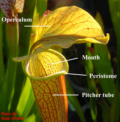 22 nov 2011 Biophysics in the News:
Mimicking the Slippery Slopes of Plant Carnivores.
22 nov 2011 Biophysics in the News:
Mimicking the Slippery Slopes of Plant Carnivores.
Biomimetics relates to using biological structures as the inspiration for human-engineered devices. Researchers at the Wyss Institute (Harvard University) got their inspiration from insect-eating pitcher plants, which use a teflon-like surface to entrap insects on which the plant feeds. The research is described in a press release (that includes some cool movies.The research was published in Nature. Aquaplaning on the peristome of pitcher plants was described in the Proceedings of the National Academy of Sciences.
7 nov 2011 Biophysics in the News: Targeting Tumours with Light Irradiation.
Many of the most efficacious treatments of cancer arise from developments in biophysics. Most notable are real-time imaging during radiation treatment of tumours, to maximize tumour irradiation and minimize damage to peripheral tissue. A biophotonic approach is even more selective.The state-of-the-art --tested in a mouse model-- is to use antibodies that bind specifically to tumour cells. The antibody has a molecule attached to it that absorbs in the infrared (infrared light can penetrate tissue quite deeply). Once photo-activated, the molecule selectively 'attacks' the cell to which it is attached.The research was published in Nature Medicine, and described by BBC News. This is but one example of BioPhotonics, a research area with great promise.
16 oct 2011 Biophysics in the News: Super-Resolution Microscopy.
Cell biophysicists like myself have been paying close attention to a revolution that gets no airplay in public news outlets: Super-Resolution Microscopy. This isn't just one technique, but a plethora of new optical and fluorescence imaging techniques that have been pushing imaging resolution well below the 'orthodox' 250 nm for light (350-650 nm wavelengths).Diatoms are used to test imaging resolution in light microscopy because of the highly regular spacing of the striae [png].Nature magazine recently posted an update on the advances so far. In time, we may be able to resolve interactions within the cell at the level of individual proteins. Imaging is something students may want to consider as a future career.
23 sep 2011 Biophysics in the News: Cicada cycles and prime numbers.
As part if a BBC documentary on math and nature (The Code), Marcus du Sautoy explains why cicadas have cycles that are prime numbers (the cicada segment is from 6:00 to 15:00 on the video). Brood X is in a class of its own, because of its vast population.
8 aug 2011 Biophysics in the News: Faster than a Speeding Bullet? Even Wired magazine gets into the act, analyzing the remarkable accelerations of a fungal spore!
Last year, students in Current Topics in Biophysics suggested this topic for a bio-ballistic assignment [pdf]. A high-speed movie of the Pilobolus spore pictured in the Wired magazine article can be seen in a youtube video, set to rousing music!
4 aug 2011 Biophysics in the News: How High Can a Tree Grow? It is not just a lecture topic, but also the subject of active research!
The latest, highlighted in a BBC news article, comes from physicists interested in allometry. They explore predictive models that account for environmental constraints, published in PLOS One.
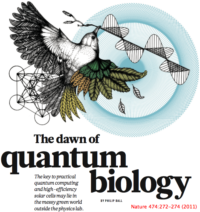 14 jul 2011 Biophysics in the News:
Quantum Biology Takes Off.
Scientists are paying more and more attention to quantum phenomena in biology: quantum entanglement in light capture in photosynthesis and the possible
role of light-induced unpaired electron spin states in biomagnetism. Both are described in a
Nature News Feature.
14 jul 2011 Biophysics in the News:
Quantum Biology Takes Off.
Scientists are paying more and more attention to quantum phenomena in biology: quantum entanglement in light capture in photosynthesis and the possible
role of light-induced unpaired electron spin states in biomagnetism. Both are described in a
Nature News Feature.
Professor Menary highlights these and other aspects of quantum biology on his Biophysics Miscellany Website.
13 jun 2011 Biophysics in the News: BBC News is highlighting research published in Nature Photonics. The researchers created laser light by placing a cell expressing green fluorescent protein (GFP) between two mirrors placed 10 microns apart.
Biological organisms use GFP for bioluminescence. The gene can be expressed in cells using standard molecular biological techniques. It has been very useful in biological research, and 'won' a Nobel prize in 2008.
Archives
6 October 2014: Here is a draft of the equations and constants [pdf] that will be provided with the term test on Thursday 9 October.
In its present state, there are three questions in the test. All three questions focus on aspects of microfluidics, for which the course notes and readings on biological pumps and nanomotors may be most helpful.
 30 September 2014
Low Reynolds Number
30 September 2014
Low Reynolds Number
A classic movie entitled Low Reynolds Number Flows starring the physicist GI Taylor has been uploaded onto YouTube. It provides a dramatic insight into the nature of low Reynolds number fluidics.
23 September 2014: Here is the first assignment in pdf format.
Please note that the assignment is due before 5:00 PM on Friday 3 October 2014. You can drop it off at my lab (Room 229 in Farquharson Building).
9 September 2014: Here is a link to optogenetics in action from Nature [youtube]. It's a good overview of the 2010 Method of the Year, all because of basic science on algal vision.
27 August 2014: Tanya Da Sylva (Bethune College Academic Life Coordinator) asked me to remind students that Bethune College offers Free Peer Tutoring and Study Sessions for multiple BIOL, CHEM, CSE, MATH, and PHYS courses. All to help students do better in their studies!
Bethune College offers a range of servces for students through the Student Ombuds Services (SOS):
There is a Bethune College Meet-the-Profs event on Thursday, September 11th at 2:30pm in 203 BC. This will be a fun, informal event where students and faculty will get a chance to interact with each other and Bethune College Peer Leaders. Refreshments will be provided - to register please go to bethune.yorku.ca/meet-the-profs-sept-11-2014
18 August 2014: The course handout [pdf] is available. The term tests are scheduled for Thursday 9 October and Tuesday 18 November.
12 August 2014: The Moodle site for the course is available: Moodle: Current Topics in Biophysics
The Moodle site is your source for course notes and other supporting material. And, there is a student forum that you can use to connect with other students in the course!
29 dec 2013: Best wishes for the new year and all of your future biophysical endeavours!
30 November 2013: The final exam is scheduled for Friday 20 December 2:00 to 4:00 PM in HNE 034. (HNE is the Health, Nursing & Environmental Studies Building south of Scott Library)
Most of the final exam will cover material presented by Dr. Jerzak, with one question from the Lew lectures --for which detailed information will be provided nearer to the date of the final exam.
Update 6 December 2013: The format of the question from the Lew lectures will be similar to past final exams. The question will cover aspects of the lectures on biological pumps and nanomotors. Any equations and constants that might be useful will be provided.
Update 16 December 2013: You will be provided with the specific equations that you require (no selection from a long list, as in previous years).
15 October 2013: The term tests will be returned to you today, then Dr. Stan Jerzak will be taking over the lectures [link].
I have enjoyed the class, for which I thank all of you!
8 October 2013:
Biophysics Club Meeting
Wednesday 16 October in Petrie Room 317 from 4:00 pm to 5:30 pm.
Refreshments will be served!Robert Moscaritolo, who graduated with the biophysics degree from York University two years ago, will make the following presentation:
Quantifying Bacterial Crowd Surfing.Before or after the presentation, Club members will elect the new President, Vice-President, Treasurer and Executive Committee.
6 October 2013: Here is a draft of the equations and constants [pdf] that will be provided with the term test on Thursday 10 October.
19 September 2013: Here is the first assignment in pdf format.
Please note that the assignment is due before 5:00 PM on Thursday 26 September 2013. You can drop it off at my lab (Room 229 in Farquharson Building).
26 aug 2013: The course handout [pdf] is available. The tests are scheduled for Thursday 10 October and Tuesday 19 November.
20 dec 2012: Best wishes for the new year and all of your future biophysical endeavours!
13 October 2012: Osmotic Pressure and the Height of a Tree.
Hot off the Presses, Steven Vogel writes about the problems using osmotic pressure to 'push' water to the top of a tree in an excerpt [png] from his new book (The Life of a Leaf --University of Chicago Press). Vogel is a champion of research on Comparative Biomechanics and has written a number of accessible books on the topic. The Life of a Leaf is a good read. He also explores capillary movement of water and why it doesn't work, a problem that might be suitable for an assignment (or a test).
09 May 2011: BPHS 2090 rated a review by SOS (Student Ombuds Service).
"Overall it's a very interesting course, and I highly recommend it, even if you're not in biophysics!"
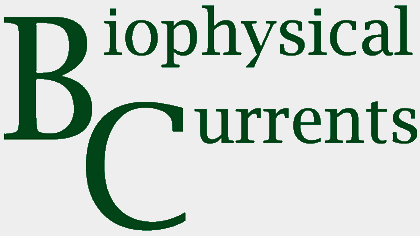 Current Topics in Biophysics (SC/BPHS 2090 3.0)
Current Topics in Biophysics (SC/BPHS 2090 3.0) 